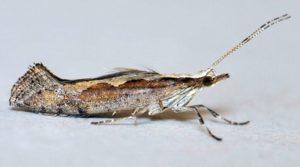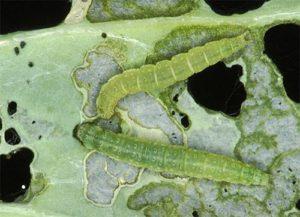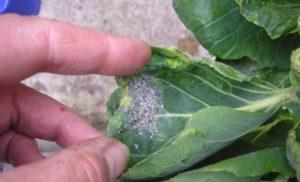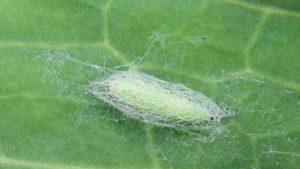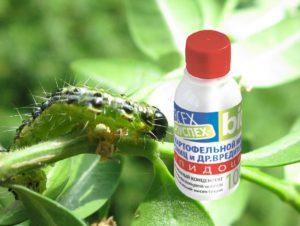Cabbage moth is a small butterfly that will cause big problems
Content
Among the many pests that infect plants of the Cruciferous family, the cabbage moth occupies a special place. Hordes of these insects are capable of completely destroying vegetable crops in the shortest possible time.
What does cabbage moth look like (photo)
Description of the pest
Name: Cabbage moth
Latin: Plutella xylostellaClass: Insects - Insecta
Squad: Lepidoptera - Lepidoptera
Family: Crescent moths - Plutellidae
 | Habitats: | garden |
 | Dangerous for: | cruciferous family |
 | Means of destruction: | chemicals, agricultural technology |
The cabbage moth is a small butterfly belonging to the sickle-winged family. Damage to plants is caused by pest caterpillars that feed on succulent leaves. The adult prefers the nectar of the inflorescences and does not damage the culture.
Biological characteristics
The cabbage butterfly has a small body size (from 15 to 17 mm). The wings are painted gray or various shades of brown. The contours are equipped with soft mobile cilia. On the front wings, a yellowish or white stripe is clearly visible.
Females have a lighter shade of wings than males. The wingspan of a butterfly is 13-16 mm. At rest, the antennae of the butterfly are directed forward. The males of the insect live for about 20 days, while the females die after 30 days.
The moth begins active activity at the end of April. Adult individuals settle on vegetable crops belonging to the Cruciferous family. Most susceptible to pest damage:
- cabbage;
- rape;
- radish;
- radish;
- turnip.
Moths are most active at night. If the years of butterflies are seen during the day, then the number of insects is too large, their settlement on plants exceeds 20% of the total area of sown crops. In late April - early May, butterflies actively mate. The next day, the female starts laying eggs. 2-5 eggs are attached to the inside of the leaf with a sticky secret specially produced by an adult.
As a result of one fertilization, a butterfly can lay about three hundred eggs. In total, during the season in the temperate zone, the female breeds about four generations of offspring.
Signs of appearance
You can determine the presence of a parasite on vegetable crops by the following signs:
- the appearance of yellow eggs on the inside of the leaf of the plant;
- damage to the integrity of the sheet plates in the form of holes of different sizes;
- the presence of a sticky web on the stem, in head buds;
- the presence of larvae on the ground parts of the plant.
- moth fluttering over crops in the evening and at night.
What is dangerous
An adult butterfly does not harm a vegetable crop. Only moth caterpillars gnaw through the leaves. Damaged leaves become stained, gradually wither and fall off. Plant growth and fruit set slow down. With extensive damage, the plant begins to rot and dies. Caterpillars move to neighboring crops.
If you do not take measures to destroy the parasite, moth larvae can destroy an adult plant in just two days. It happened that pest raids destroyed entire rapeseed fields in a week.
Methods of struggle
It is necessary to apply means of destruction of the parasite several times, because. all stages of insect development are present simultaneously on the plant. The newly hatched larva is under the tight protection of the mine, so neither chemical nor biological agents harm it. The most sensitive to chemicals are older caterpillars.
To get rid of moths, use the following methods:
- agrotechnical;
- the use of chemicals-insecticides;
- the use of biological pesticides;
- folk ways.
Agrotechnics
Agricultural practices prevent the spread of insects and destroy the moth at the initial stages of its development.
Pest control consists of the following activities:
- Crop rotation. In the areas sown with cruciferous crops belonging to another family of plants are grown in subsequent years.
- Alternation cultivated areas of cruciferous crops with stripes planted with other vegetable crops. For example, behind a rapeseed field there is a potato field or cereal crops.
- After harvesting it is necessary destroy all plant debris.
- Before the onset of winter, it is necessary to make deep tillage of the soil. In the spring, just before the start of the sowing campaign, the event should be repeated.
- Throughout the entire period of cruciferous cultivation, it is necessary to systematically remove weeds plants.
Experienced farmers advise planting early varieties of rapeseed so that by the end of April - beginning of May the culture has time to get stronger.
Chemical methods
When using chemical insecticides, it should be remembered that the treatment should be carried out at least 20 days before the start of harvest. Chemicals absorbed into the plant can cause poisoning in humans.
Chemical preparations against pests are divided into several groups, differing from each other in the way they act on the parasite.
Used against cabbage moth larvae contact-intestinal and systemic insecticides. Poisons enter the body of the caterpillar along with the pulp and juice of the plant and cause poisoning and death.
Systemic insecticides are introduced into the soil and, together with nutrients, are absorbed by the crop. When moth larvae eat poisoned leaves, the drug chemical compounds act on the nervous system of the insect, causing paralysis. The pest dies.
In addition to universal chemical control agents applicable to all types of parasites, there is a specially developed group of chemicals called Lavricides. They have a detrimental effect only on caterpillars and do not pose a danger to beneficial pollinating insects.
Most popular chemical insecticides are:
- Boreas;
- Herald;
- Barguzin;
- Alfachance;
- Karbofos;
- Intavir.
When mixing a chemical preparation with water, it is necessary to strictly adhere to the proportions indicated in the instructions for use. Too concentrated a solution can harm the plant. When spraying, safety measures should be observed: wear rubber gloves and a respirator.
It is necessary to treat the culture with chemical insecticides, taking into account the weather forecast. If it rains after spraying the drug, you should not expect a positive effect.
It is recommended to repeat the destruction procedure after a few days, even if there are no caterpillars or eggs on the leaves. Sometimes small larvae climb into the ovary of the fetus, and go unnoticed during a cursory examination.

Cabbage moth is a pest of cruciferous plants.
Biological methods
Biological pesticides no less effectively destroy the cabbage moth than chemicals. They include fungal infections and pathogenic bacteria that cause the death of harmful insects. The preparations are introduced into the soil, dissolved and, together with other substances, are absorbed by the culture. After some time, a sufficient amount of bacteria accumulates in the juice of the plant, which have a detrimental effect on parasites.
It should be borne in mind that It will take time to kill bacteria. Therefore, if the degree of infection exceeds the permissible levels, it is necessary to first use chemical preparations, and then fix the result using biological methods. Lepidocid and Bactofit are the most effective.
The caterpillar's body can adapt to bacterial strains after a while, so several different types of bacterial pesticides should be alternated.
Preventive measures
Invasion of the cabbage moth can be avoided by performing preventive measures, which include:
- Regular thorough inspection of the crop for the presence of a pest.
- Timely removal of weeds not only in beds with crops that are a source of moth food, but also in nearby garden plantings.
- Some gardeners are planted around the perimeter of vegetable plants of the Cruciferous family of tobacco, which has a pungent odor that repels adults.
- You can run a frog or a lizard into the garden. Butterfly larvae are their main food source.
- Sprinkling the ground part of the plant with bay leaves, previously ground into powder.
Some gardeners prevent the spread of a harmful insect with the help of traps.
Two types of baits are used: glue and glueless. A glue trap is a fixation on a plant with a sticky solution of an attractive signal for butterflies (for example, a white object that is clearly visible at night).
A glueless trap is made of thick paper or cardboard. The material is rolled up in such a way that a butterfly that has flown into the trap can no longer get out of it.
